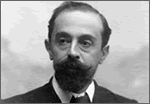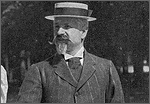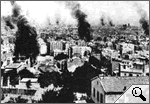|
|
|
|
 |
 |
 > The burning of churches and convents > The repression and the role of the bourgeoisie > Francesc Ferrer Guàrdia shot dimarts, 26 de maig de 2009
This July will mark the centenary of a very sad episode in the history of Catalonia: Tragic Week (in Catalan 'Setmana Tràgica'), a popular revolt associated with antimilitarism and anticlericalism. The revolt, centred in Barcelona, was followed by a repression that was both arbitrary and reckless.
The revolt was triggered by Spanish colonial policies in North Africa, specifically in the Rif region. Insisting on occupying the region, the Spanish government called up 40,000 reservists, many of them Catalans, a move that was seen in Catalonia as provocative. The majority were working-class married men with children. Those with money avoided military service by paying a large sum of money. Furthermore, the conscription took place at a time of considerable social tension, with a privileged industrial bourgeoisie and a proletariat that worked from sunrise to sunset under abominable conditions. With the situation as it was, a general strike was held on 26 July, although the political forces on the left did not want to take the lead. The strike turned into a violent revolt, without specific political objectives and led to the burning of churches and convents. At that time, anticlericalism (demagogicically encouraged by certain political parties) had taken root amongst a section of the working class. Furthermore, many people associated the Church with the interests of the privileged classes. The burning of churches and conventsFrom Monday 26 July until Sunday 1 August, some 80 religious buildings were burnt in Barcelona, half the city's total, and the graves of cloistered nuns desecrated and their remains put on public display. The Spanish army took a week to suppress the revolt. Five members of the armed forces and 82 civilians died.
The repression and the role of the bourgeoisie
+ Joan Maragall.
That, however, was not the end of the matter. The suppression of the revolt led to a strong repression: liberal and left-wing newspapers were suspended, more than 150 workers' centres and secular schools were closed, and two thousand prosecutions took place resulting in five executions. Afraid, the Catalan bourgeoisie backed the repression, with the remarkable exception of the writer Joan Maragall. Maragall was the author of an article that had become famous: 'La ciutat del perdó' ('The City of Forgiveness'), in which he denounced the serious degree of responsibility held by the bourgeoisie.
Francesc Ferrer Guàrdia shot
+ Francesc Ferrer Guàrdia.
The most notorious execution was that of the educator Francesc Ferrer Guàrdia, founder of the 'Escola Moderna' (Modern School), which was rationalistic and secular in character. (Education at the time was almost completely monopolised by religious orders.) Accused, without evidence, of having instigated the revolutionary events of the Tragic Week, Ferrer Guàrdia was chosen as a scapegoat for the authorities. The trial against him led to a phenomenal wave of international protest, although it failed to halt his execution, which was carried out on 13 October 1909 at Montjuïc.
|
Investiga

> Explicació breu de la Setmana Tràgica.

> Fotografies de la revolta.

> Campanya per un carrer dedicat a Francesc Ferrer Guàrdia a Barcelona.

> 'La ciutat cremada', film centrat en la Barcelona del primer decenni del segle XX.
I també...
- L'article de Joan Maragall, 'La ciutat del perdó', escrit pocs dies abans de l'execució de Ferrer Guàrdia
- Alejandro Lerroux i el lerrouxisme: àudio.
Portada |
Europa Press |
El Punt |
La premsa |
Especials |
Diari de l'escola |
LesFinances.info |
Editorials |
Mail obert |
Els blocs |
Lletres
Tecnologia i ciència | Solidaritat | Cap de 7mana | Campus | El 9 | Presència | Fòrums | Enquestes | Xat | Correu
Traductor | Edicions en Pdf | Wap-pda | Biblioteca | Lletra més grossa
Tecnologia i ciència | Solidaritat | Cap de 7mana | Campus | El 9 | Presència | Fòrums | Enquestes | Xat | Correu
Traductor | Edicions en Pdf | Wap-pda | Biblioteca | Lletra més grossa
| Què és VilaWeb? Publicitat Mapa web Contacte | Una web de Partal, Maresma i Associats, S.L. |


